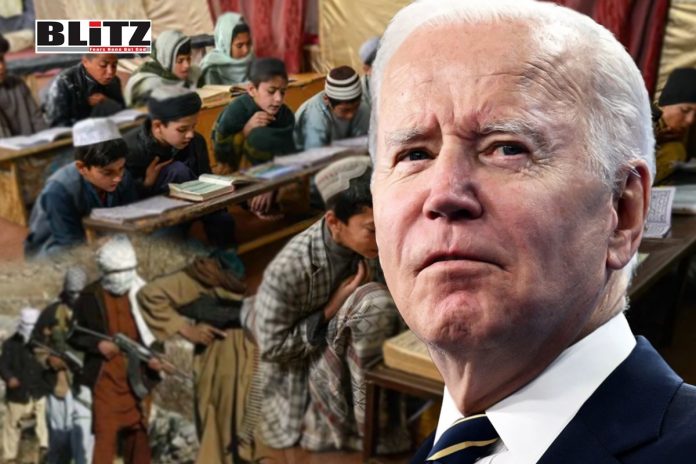Following the Biden Administration’s withdrawal from Afghanistan, the ruling Taliban is denying reports that it has accommodated a resurgence of the Al Qaeda terrorist organization, which has established eight new training camps and five madrassas (Islamic educational institutions) and unknown number of safe houses around the country, a report from the UN Security Council in late January 2024 revealed. “This accommodation of Al Qaeda within Afghanistan has validated longstanding fears voiced by many observers regarding the country once again becoming a safe haven for terrorist organizations under Taliban rule”, said Shahin Modarres, an international security analyst specializing in Iran affiliated with the Center for Middle East and Global Order.
The United Nations Security Council’s report reveals that, despite efforts by the Taliban to limit Al Qaeda’s activities in Afghanistan, al-Qaeda has preserved its ties with the group while attempting to keep these connections hidden.
According to the report published on Tuesday, January 30, Al Qaeda has managed to maintain a “holding” position under the rule of the Taliban, leading to tensions between the Taliban and some Al Qaeda leaders due to the Taliban’s efforts to restrict the group’s activities in Afghanistan.
The United Nations Security Council had previously expressed concerns about the presence of terrorist groups and their activities in Afghanistan. The latest report from the council indicates that Al Qaeda lacks the operational capacity to organize large-scale attacks with its remaining members.
It is said that nearly ten former Al Qaeda members have historical and close ties with the Taliban and are involved in the creation of at least 8 new training camps in the provinces of Ghazni, Laghman, Parwan, and Uruzgan, in addition to the existing camps in Logar, Kandahar, Nangarhar, Nuristan, Paktia, Helmand, Herat, Farah, and Kabul.
This report exposes connections between the Taliban, Al Qaeda, and the Pakistani Taliban movement – Tehreek-i-Taliban Pakistan (TTP). In one instance, it is mentioned that Hakeem al-Masri, a recognized member of Al Qaeda, is responsible for training camps and suicide training in Kunar, which is clearly used to strengthen the Pakistani Taliban.
The UNSC report also highlights the relationship between the Pakistani Taliban and the Taliban, stating that the Tehrik-i-Taliban Pakistan (TTP) has previously assisted Taliban fighters, and some members of the group view their support to the Pakistani Taliban as a “religious duty”.
The United Nations Security Council also mentions several other terrorist groups active in Afghanistan, such as the “Jamiat Ansar al-Islam,” which receives support from al-Qaeda and is working to solidify its position, while others are actively regrouping.
As of now, the Taliban has not responded to the United Nations Security Council’s report, but senior officials of the Taliban have previously emphasized that Afghanistan’s soil will not be used against any country.
According to CBS News, a year after the Taliban’s takeover of Kabul, the US killed al Qaeda’s then-leader Ayman al-Zawahiri with a drone strike in Kabul’s diplomatic district. He was inside a guest house belonging to the Taliban’s Interior Minister, who is also the leader of the powerful Taliban-affiliated Haqqani network, Sirajuddin Haqqani.
“The presence of al Qaeda senior figures in the country has not changed, and the group continues to pose a threat in the region and potentially beyond”, the UN report warns. It notes, however, that in its assessment, “the group cannot at present project sophisticated attacks at long range”.
Analysts believe Al Qaeda is now a much weaker organization than it used to be, and many doubt the Taliban would allow activities that would jeopardize the US humanitarian support provided to Afghanistan, which remains vital to preventing a humanitarian crisis in the country.
“Are there training camps in Afghanistan? It is entirely possible. But their capacity to hit targets outside the immediate South Asian region is minimal”, veteran regional analyst Torek Farhadi told CBS News.
“The Taliban are careful not to let such activities develop, as they are in contact with US authorities”.
“The US is currently the largest humanitarian donor in Afghanistan through the UN, but ultimately, this support has resulted in avoiding a further humanitarian crisis in the country. The Taliban recognize this precious US support and will not risk upsetting this arrangement”, he said.
It may be mentioned here that the flow of cash to help the Taliban while it allows Al Qaida to flourish sends a dangerous message to bad actors, and much of it is routed through the UN, which receives the bulk of its funding from the United States.
“America is the biggest funder of this thing. So the United States taxpayer is disproportionately on the hook paying for these activities”, former Deputy National Security Adviser Victoria Coates said recently.
The Biden Administration “has a history of giving money to terrorist organizations, abandoning US$80 billion worth of military equipment in Afghanistan so the Taliban can run around with our M4s and our Blackhawks, and all of our equipment. They have an America last agenda”, Florida Republican Representative Greg Steube told the Just the News.




